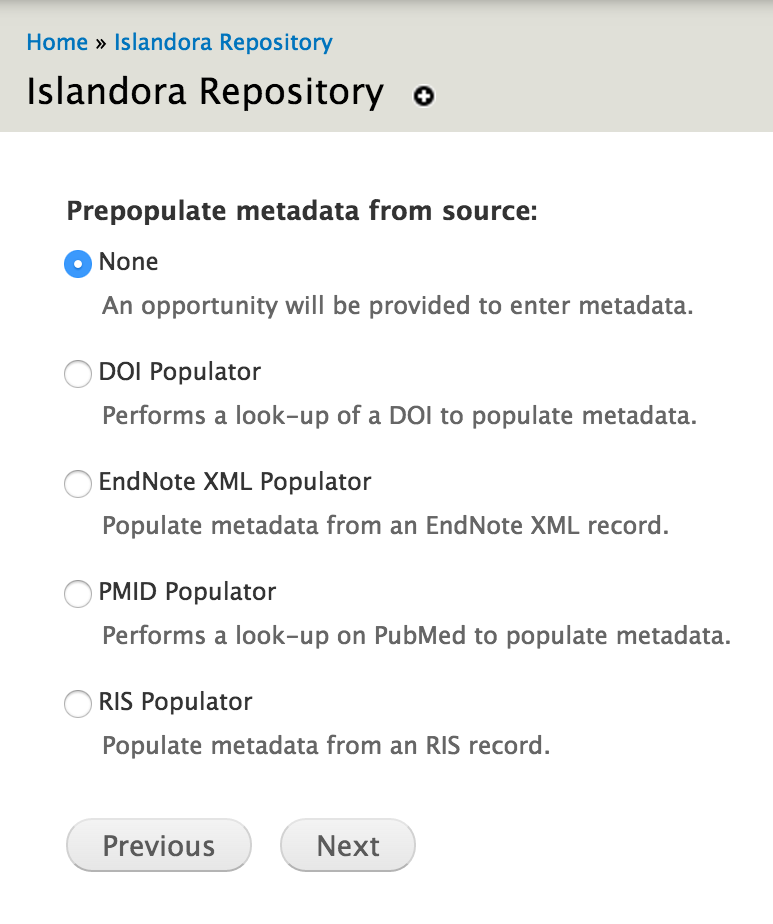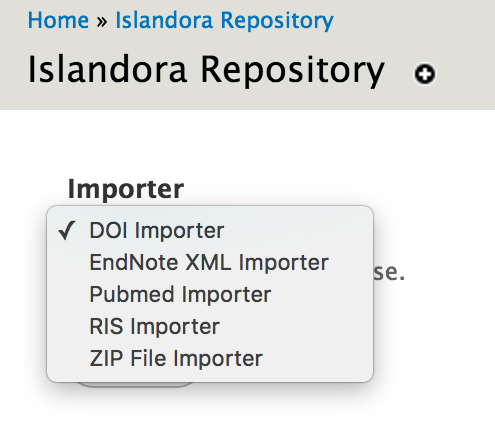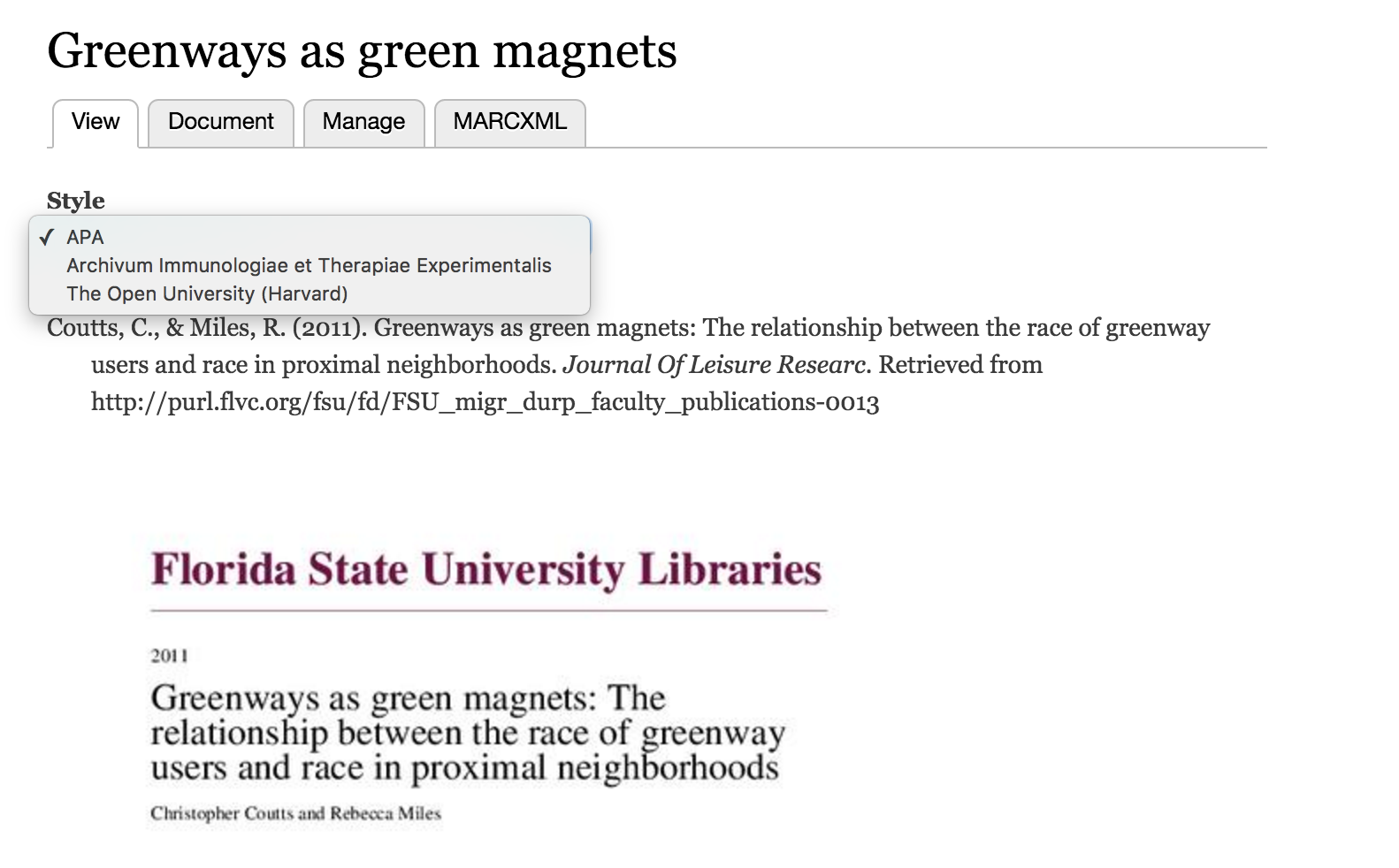...
Islandora Scholar also requires the Citeproc, CSL and Bibutils modules in order to be enabled, but these modules are included in the /modules directory of base Islandora Scholar module.
...
Also, the included Bibutils submodule only provides PHP interface to the Bibutils tool itself, which must be installed separately on the underlying operating system. Follow these instructions for installing Bibutils.
...
While "Scholar Core" is not an official community term, it can be a helpful way to keep track of the numerous features Islandora Scholar offers. In this context, "core" features are those that come from the islandora_scholar.module file itself as opposed to coming from one of the numerous submodules which can be enabled or disabled independently of the main Islandora Scholar module.
Citation & Thesis Content Models
The core Islandora Scholar module provides two new content models: the citationCModel and the thesisCModel. The citation cmodel is intended for general scholarly works, while the thesis cmodel is for handling electronic theses and dissertations (ETDs). While the datastream structure and default display of these two cmodels is nearly identical, they can be tweaked separately to accommodate the different use cases one may have for theses vs. other scholarly works, such as altered displays or separate metadata forms.
Please note that the citationCModel and thesisCModel are in the "ir" namespace, as opposed to the standard "islandora" namespace that other cmodels have had in the past. Due to this nonstandard namespace, Islandora instances that make use of namespace restrictions will need to enable the "ir" namespace in order for the citation & thesis cmodels to work.
Sherpa/RoMEO
Another feature in Scholar Core is Sherpa/RoMEO integration, which can be used to retrieve the copyright & self-archiving policies of various academic publishers. In order to use this feature you must first configure it in the Scholar configuration admin menu at 'admin/islandora/solution_pack_config/scholar' by checking the "Enable RoMEO attempts" checkbox and providing a Sherpa/RoMEO API key. It will also only work on objects that have an identifier field with the type "ISSN" in their MODS record. Once properly set up, Islandora Scholar will use an object's ISSN number to query Sherpa/RoMEO's database of publishers and return the host publisher's copyright/self-archiving policy which shows up in the object's display.
...
Scholar provides options for importing objects from various sources. The RIS Importer and EndNoteXML Importer submodules allow users to take citation data files exported from other sources (such as RefWorks, EndNote or Zotero) and turn them into Islandora objects using the standard Islandora importer interface (similar to using the zip importer). The DOI Importer and PMID Importer submodules work in much the same way, but instead of using files exported by other citation managers they use Digital Object Identifier (DOI) or PubMed ID (PMID) strings.
 Image Added
Image Added Image Added
Image Added
Citation Collection & Citation Style Management
The Islandora Bibliography submodule extends the Islandora slandora Bookmark module to to allow it to handle collections of scholarly citations, which can be dynamically restyled with the help of the Citeproc and CSL submodules, as well as . They can also be exported in RIS, RTF or PDF format with the Exporter submodule.
In order to access new citation styles, go to the Zotero CSL Repository and download whatever CSL files you want to use. You can then upload your CSL files using the CSL admin page at admin/islandora/tools/csl and choose a default style to display on your citation & thesis object pages. If you want your users to be able to dynamically choose any available citation style from the citation/thesis object display interface, make sure to check the "Let users choose display CSL" checkbox at the bottom of the Islandora Scholar admin page at admin/islandora/solution_pack_config/scholar.
 Image Added
Image Added
If you want your users to be able to dynamically choose any available citation style from the citation/thesis object display interface, make sure to check the "Let users choose display CSL" checkbox at the bottom of the Islandora Scholar admin page at admin/islandora/solution_pack_config/scholar.
 Image Added
Image Added
Google Scholar Integration
Getting indexed by Google Scholar is a primary concern for any institutional repository due to the extreme popularity of Google Scholar. Most people will get to the documents in your IR via its overwhelming popularity with researchers. A properly configured IR should be seeing most of its visitors coming from Google Scholar, but Google Scholar has many requirements for repositories who want to be indexed. The Islandora Google Scholar submodule pulls relevant information from the MODS record of citation & thesis cmodels and turns it into meta tags and embeds it into the HTML of the display page which is the primary way that Google Scholar learns about your repository and its contents. See the meta tags with the "citation_" prefix in the screenshot below:
 Reading embedded HTML meta tags in the head of an object's display page is the primary way that Google
Reading embedded HTML meta tags in the head of an object's display page is the primary way that Google
Scholar
...
Scholar Embargoes
The Scholar Embargo submodule is very similar to (and can even be used in conjunction with) the Islandora IP Embargo module. Scholar Embargo allows you to suppress the display of objects in collections entirely, or allow the objects to display but disable a specified datastream on an object. Embargoes may be indefinite (meaning that they will persist until manually lifted) or temporary (meaning that they will persist until the specified expiration date chosen by an administrator, with email notifications 10 days before and on the day of an embargoes expiration).
...
You may also use the "Manage Embargoed Items" tab in the Islandora Scholar Embargo admin menu to see all objects that are currently under embargo (very useful!).

It is worth noting that the current best practice in the world of institutional repositories seems to be exposing the object display and metadata, but blocking the viewing or downloading of the full text record (typically a PDF file). This is so users can know what information is in the system through collection displays or search results, even if the system blocks them from fully accessing it. Many faculty and students like to check to make sure their records are in the repository and still embargoed, and when they can't find their record they may misunderstand and think it hasn't been loaded.
In order to manage place embargoes on objects, you must grant the "Manage embargo on any objects" permission to the appropriate user roles under the Islandora Scholar Embargo section of admin/people/permissions. This will allow a user to place object and datastream embargoes on objects, as well as remove or update datastream embargoes. Due to issues with the connection between Drupal permissions and the way Scholar Embargo implements its embargo policies through XACML, currently only the object's owner will be able to remove or update object embargoes even if a user has the "Manage embargo on any objects" permission. This is because the XACML policy works independently of Drupal permissions, and the embargo XACML policy will block everyone except the object's owner from managing the object at all once embargoed regardless of what Drupal permissions they have. A fix for this is in the works and should be part of the Islandora 7.x-1.8 release.
...






